Cardiac output-guided maternal positioning in pregnancy-- can it improve outcomes?
IF 4.1
2区 医学
Q1 OBSTETRICS & GYNECOLOGY
Best Practice & Research Clinical Obstetrics & Gynaecology
Pub Date : 2025-03-21
DOI:10.1016/j.bpobgyn.2025.102596
引用次数: 0
Abstract
Chronic and recurrent obstruction of the inferior vena cava by the uterus during the second half of pregnancy are theorized to contribute to the causation of preeclampsia, fetal growth restriction, preterm birth, dysfunctional labor and postpartum uterine atony. Such obstruction is hypothesized to be asymptomatic for the mother but can be detected and minimized by non-invasive continuous trending of maternal cardiac output, because positional decreases in cardiac output can serve as a warning signal of obstruction of venous return. Injury may be caused by 1) decreased cardiac output, 2) increased uterine venous and intervillous pressures and 3) decreased intervillous perfusion. Wide variations in intervillous oxygen tension may be more harmful than low but stable oxygen tension. Clinical examples of asymptomatic but dramatic positional changes in maternal cardiac output in hospitalized patients are shown. Further research should begin with laboring patients, since cardiac output changes dramatically over time and with position during labor.

心输出量引导孕妇妊娠定位——能改善结局吗?
妊娠后半期子宫慢性和复发性下腔静脉阻塞被认为是导致先兆子痫、胎儿生长受限、早产、功能障碍分娩和产后子宫张力失调的原因。假设这种梗阻对母亲来说是无症状的,但可以通过无创的母亲心排血量连续趋势来检测和最小化,因为心排血量的体位性减少可以作为静脉回流梗阻的警告信号。损伤的原因可能有:1)心输出量减少,2)子宫静脉和绒毛间压力增加,3)绒毛间灌注减少。绒毛间氧张力的大变化可能比低但稳定的氧张力更有害。临床例子无症状,但戏剧性的位置变化,产妇心输出量在住院患者显示。进一步的研究应该从分娩患者开始,因为心输出量随着时间的推移和分娩时的体位而急剧变化。
本文章由计算机程序翻译,如有差异,请以英文原文为准。
求助全文
约1分钟内获得全文
求助全文
来源期刊
CiteScore
9.40
自引率
1.80%
发文量
113
审稿时长
54 days
期刊介绍:
In practical paperback format, each 200 page topic-based issue of Best Practice & Research Clinical Obstetrics & Gynaecology will provide a comprehensive review of current clinical practice and thinking within the specialties of obstetrics and gynaecology.
All chapters take the form of practical, evidence-based reviews that seek to address key clinical issues of diagnosis, treatment and patient management.
Each issue follows a problem-orientated approach that focuses on the key questions to be addressed, clearly defining what is known and not known. Management will be described in practical terms so that it can be applied to the individual patient.

 求助内容:
求助内容: 应助结果提醒方式:
应助结果提醒方式:


